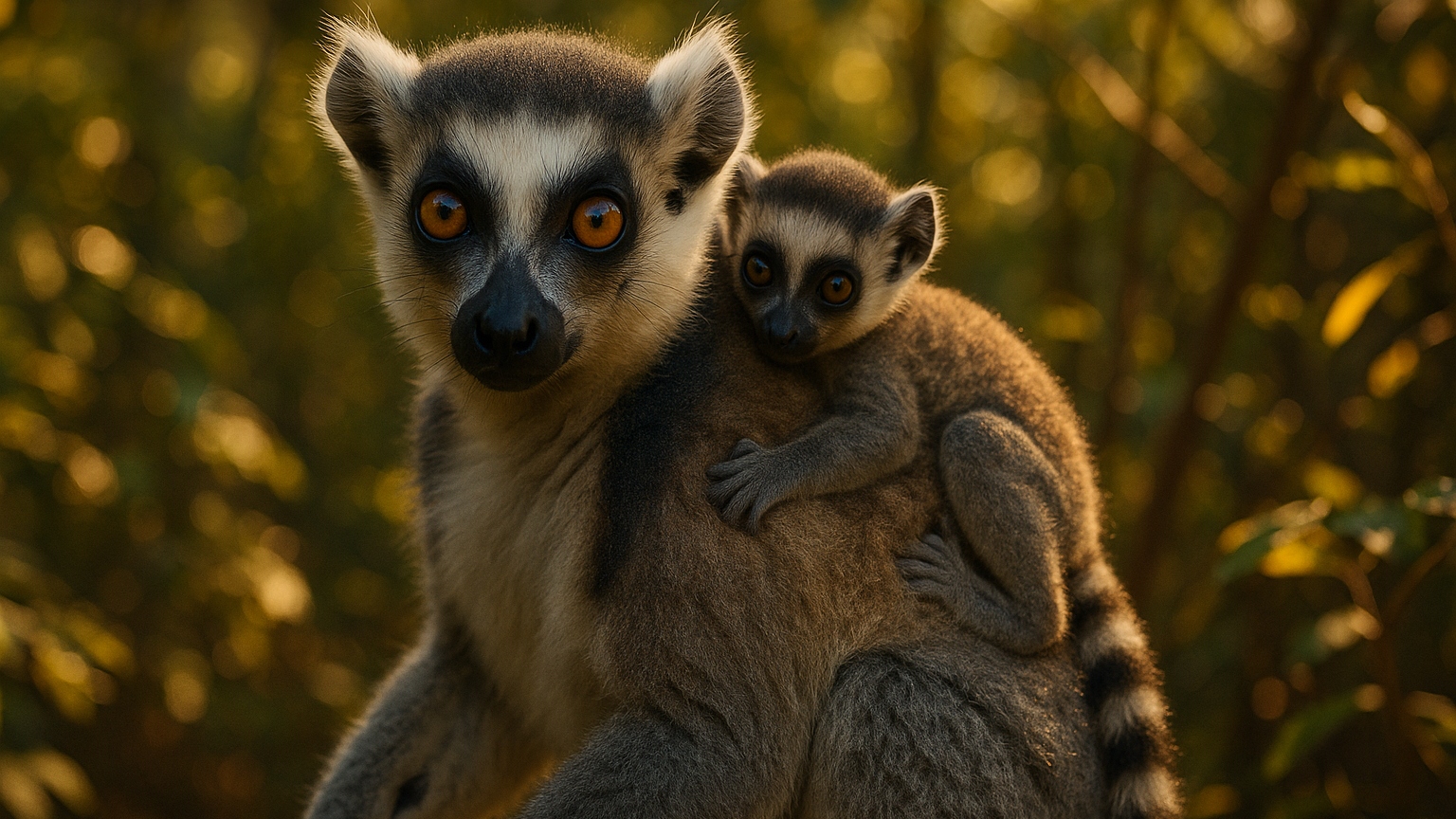Ring-tailed Lemur: The Striped Spirit of Madagascar
There is perhaps no primate more iconic or instantly recognizable than the ring-tailed lemur (Lemur catta). With its bold black-and-white striped tail waving like a flag and piercing amber eyes, the ring-tailed lemur is more than just a charismatic face of Madagascar’s biodiversity—it’s a symbol of a place and a story that spans millions of years. Known for its unique appearance, vocal communication, social behavior, and sunbathing posture, this curious creature has fascinated scientists and wildlife lovers alike.
Found only on the island of Madagascar, ring-tailed lemurs belong to a lineage that split from all other primates long ago. They are part of the Lemuridae family, which includes other true lemurs, and are among the most terrestrial of their kind. Despite their fame and charm, these lemurs face growing challenges in the wild, and their survival depends on a delicate balance between nature and human development. But before looking into their uncertain future, let’s first explore the fascinating life of this tail-waving wonder of the forest.
A Madagascar Original
The ring-tailed lemur is endemic to the southern and southwestern regions of Madagascar, the only place in the world where lemurs naturally occur. Isolated from mainland Africa for over 80 million years, Madagascar evolved into a laboratory of evolutionary experiments, and lemurs are among its most successful outcomes. While over 100 lemur species inhabit the island, the ring-tailed lemur is arguably the most famous, often serving as the “poster primate” for conservation campaigns and documentaries.
Unlike many of its arboreal cousins, the ring-tailed lemur spends a significant amount of time on the ground. This terrestrial tendency sets it apart in a world dominated by tree-dwellers, and it plays a key role in shaping its social structure and behavior. The terrain they occupy ranges from dry deciduous forests to spiny bush landscapes, and they often adapt to human-altered environments like gallery forests and degraded scrubland.
The Look: Tail, Eyes, and Elegance
There’s no mistaking a ring-tailed lemur once you’ve seen one. It’s their long, vividly striped tail—banded with alternating black and white rings—that makes them unforgettable. While the tail is not prehensile and cannot grasp branches, it is used like a banner for communication, especially when traveling through thick undergrowth or keeping a group together during terrestrial foraging. The tail can be nearly two feet long, longer than the body itself, which measures up to 18 inches.
Their fur is dense and soft, primarily gray on the back and limbs, with a white underside. Their face is white with a distinctive black triangular “mask” around the eyes and nose. Perhaps their most striking features are their large, golden-orange eyes, which give them an intense, almost hypnotic gaze and are highly adapted for their crepuscular (dawn and dusk) activity. The average adult ring-tailed lemur weighs around five to seven pounds, with males and females being roughly the same size. However, females are dominant—an uncommon trait among primates but a key part of ring-tailed lemur society.
Social Life: Matriarchy and Mischief
Ring-tailed lemurs are among the most social of all lemur species, living in troops that can range from 6 to 30 individuals. These groups are typically led by a dominant female who calls the shots in everything from foraging to grooming. Female dominance is strictly enforced, and males must navigate a complex hierarchy that changes throughout the year, especially during mating season. Life in a troop is noisy and vibrant. Lemurs communicate using a wide variety of vocalizations, scent markings, and physical gestures.
From alarm calls that warn of predators to soft purrs and clicks used in close-contact grooming, their vocal repertoire is surprisingly rich. Males engage in “stink fights” during mating season, rubbing scent glands on their wrists and tails before wafting the scent toward rivals to assert dominance or deter confrontation. Grooming is another critical part of social bonding. Lemurs use a specialized “tooth comb”—a group of forward-facing lower teeth—to clean each other’s fur and reinforce alliances. Young lemurs grow up in this complex social environment, learning behaviors by watching adults and participating in play.
Diet and Daily Routines
Ring-tailed lemurs are omnivorous but primarily folivorous and frugivorous. Their diet includes a mix of leaves, fruits, flowers, bark, and sap, depending on seasonal availability. They are particularly fond of the tamarind tree, whose fruits and leaves provide both nutrition and hydration. In times of scarcity, they will also consume insects, small vertebrates, or even bird eggs.
A typical day begins at sunrise, when the troop emerges from their sleeping trees to warm themselves in the early morning sun. In one of the most endearing and unique behaviors in the primate world, lemurs will sit facing the sun in a “sun-worshipping” pose, arms outstretched, soaking in the heat to kick-start their metabolism. Following sunbathing, the group spends hours foraging, resting, and grooming. Activity slows during the heat of the day and picks up again in the late afternoon. At dusk, they return to trees or rocky outcroppings to sleep, selecting sleeping sites that offer both safety and warmth.

Breeding and Family Life
Ring-tailed lemurs have a highly seasonal breeding cycle. Mating typically occurs in late April or May, timed with the end of the rainy season. Females are only fertile for about 24 hours during this window, leading to intense competition among males. Dominance plays a major role in determining reproductive success, with higher-ranking males enjoying more access to receptive females.
Gestation lasts about 135 days, and infants are usually born between August and September. A single offspring is most common, though twins occasionally occur. Newborns cling to their mother’s belly and transition to riding on her back within a few weeks. Weaning begins around 4 to 6 months of age, but juveniles continue to rely on their mothers and the troop for social learning. Female lemurs remain in the troop they were born into, helping to maintain stable matrilines, while males typically emigrate between groups at sexual maturity. This dispersal helps reduce inbreeding and adds to the dynamic complexity of lemur society.
Intelligence and Communication
Though they are not tool users like chimpanzees or some monkeys, ring-tailed lemurs exhibit impressive cognitive abilities. They can remember the locations of food sources, solve simple puzzles, and learn from observation. In both wild and captive settings, they display strong spatial awareness and social memory, recognizing individual troop members and remembering social interactions over long periods.
Communication in ring-tailed lemurs goes far beyond vocal sounds. They use more than two dozen distinct calls, including contact calls, alarm barks, and territorial howls. Scent plays an equally important role. Lemurs have scent glands on their wrists, chests, and genitals, which they use to mark territory, convey reproductive status, and assert dominance. Their tails act as scent-distributing tools, especially in competitive male displays. Their body language is also expressive. Tail-raising signals alertness or troop movement, while grooming posture and eye contact convey trust or submission. Altogether, this complex web of communication allows for sophisticated social dynamics and coordinated group behavior.
Predators and Natural Challenges
In the wild, ring-tailed lemurs face a number of predators including fossas (Madagascar’s top mammalian predator), birds of prey, and large snakes. Their defense strategies include alarm calls, mobbing behavior, and strategic fleeing to trees or rocky cliffs. Troops rely on vigilance and coordination to spot danger early, and mothers are fiercely protective of their young. Environmental challenges such as drought, food scarcity, and inter-group conflict can also affect lemur populations. In lean years, the competition for food intensifies, and the risk of infant mortality rises. Lemurs must constantly adapt to a landscape that, while stunningly diverse, is not always forgiving.

Conservation: A Cautious Hope
The ring-tailed lemur is currently listed as “Endangered” on the IUCN Red List. Despite being one of the most well-known lemurs, it faces significant threats from habitat destruction, hunting, and the illegal pet trade. Madagascar has experienced rapid deforestation due to slash-and-burn agriculture, charcoal production, and mining. As forests disappear, so do the ecosystems lemurs depend upon. Nevertheless, conservationists are working tirelessly to reverse this trend. Protected areas such as Andringitra, Isalo, and Anja Community Reserve offer safe havens for wild populations. Community-based conservation initiatives that involve local people in ecotourism, sustainable agriculture, and forest management have shown promise.
Zoos and research centers around the world have also played a role in conservation through captive breeding, public education, and scientific study. These efforts, while not a substitute for habitat preservation, provide valuable insurance populations and help raise global awareness. There’s cautious optimism that with sustained effort, the ring-tailed lemur’s future can be safeguarded—not just for its own sake, but for the preservation of Madagascar’s incredible natural legacy.
Ring-tailed Lemurs in Culture and Research
The ring-tailed lemur’s popularity extends far beyond Madagascar. Thanks to its dramatic looks and social charisma, it has become a fixture in wildlife documentaries, animated films, and educational media. But beyond the pop culture fame lies a creature of immense scientific interest. Researchers have studied ring-tailed lemurs to gain insights into primate evolution, social systems, communication, and even climate change. As a basal primate—more primitive than monkeys and apes in some anatomical respects—Lemur catta serves as a living glimpse into the early stages of primate development. In Malagasy culture, lemurs are sometimes associated with spirits or ancestors, earning them respect as sacred beings in some regions. Local taboos known as “fady” can protect them from harm in certain communities, although these traditions are increasingly under pressure from economic hardship and external influence.
A Tail of Balance and Beauty
The ring-tailed lemur is many things—a social strategist, a charismatic ambassador for conservation, a creature shaped by ancient isolation, and a modern symbol of biological resilience. It bridges the past and present, surviving in landscapes that echo with the history of an island unlike any other on Earth. Whether basking in the morning sun, leading a troop through dry forest trails, or peering curiously through the leaves, the ring-tailed lemur continues to enchant those who encounter it. It reminds us that beauty and complexity often go hand in hand, and that some of nature’s most brilliant stories come from the places we least expect.

